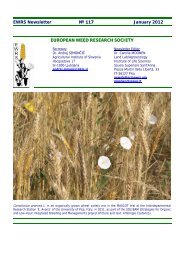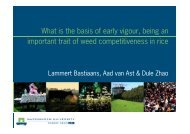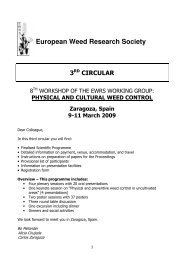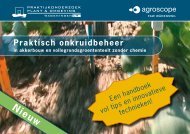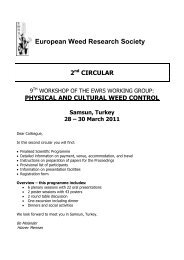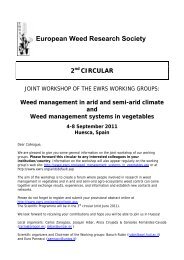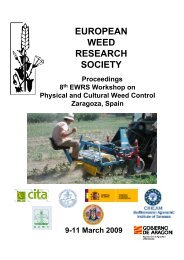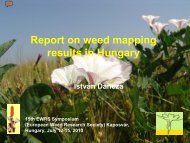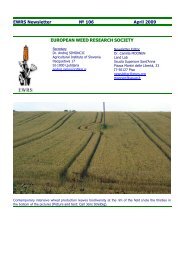Physical and Cultural Weed Control Working Group of - European ...
Physical and Cultural Weed Control Working Group of - European ...
Physical and Cultural Weed Control Working Group of - European ...
Create successful ePaper yourself
Turn your PDF publications into a flip-book with our unique Google optimized e-Paper software.
9 th EWRS Workshop on <strong>Physical</strong> <strong>and</strong> <strong>Cultural</strong> <strong>Weed</strong> <strong>Control</strong> 51<br />
Samsun, Turkey, 28 – 30 March 2011<br />
is most strongly manifested by young fruit trees, before their first fruiting. During this period their<br />
root systems are shallow <strong>and</strong> the competition for the factors, necessary for vegetative growth, is<br />
most pronounced. Two main types <strong>of</strong> weed associations are differentiated in fruit tree plantings.<br />
These are the earthed-up type <strong>and</strong> meadow type (Tonev et al., 2007). In young plantings <strong>and</strong><br />
gardens where regular soil cultivation is performed, weed associations <strong>of</strong> the earthed-up type are<br />
common. The main weed species included in it are representatives <strong>of</strong> the late spring weeds:<br />
Chenopodium album (L.) (White Goosefoot), Amaranthus retr<strong>of</strong>lexus (L.) (Red-root Amaranth),<br />
Xanthium strumarium (L.) (Rough Cocklebur), Polygonum aviculare (L.) (Common Knotgrass),<br />
Portulaca oleracea (L.) (Common Purslane), Solanum nigrum (L.) (<strong>European</strong> Black Nightshade),<br />
Erigeron canadensis (L.) (Canadian Horseweed), Datura stramonium (L.) (Jimsonweed), etc. Other<br />
species belonging to this association are representatives <strong>of</strong> the early spring <strong>and</strong> winter-spring weeds,<br />
as well as <strong>of</strong> the group <strong>of</strong> ephemerals: Stellaria media (L.) (Common Chickweed), Capsella bursapastoris<br />
(L.) Medic (Shepherd’s Purse), Senecio vulgaris (L.) (Common Groundsel), Veronica<br />
hederifolia (L.) (Ivy-leaved Speedwell), Veronica agrestis (L.) (Green Field Speedwell), Lamium<br />
purpureum (L.) (Red Deadnettle), Lamium amplexicaule (L.) (Henbit Deadnettle), etc. Perennial<br />
weeds forming rhizomes <strong>and</strong> root <strong>of</strong>fshoots are represented as accompanying species.<br />
In fruit tree plantings grown under poor agrotechnics, where no annual cultivation <strong>of</strong> the soil is<br />
being performed <strong>and</strong> no herbicides are applied, the weed association is <strong>of</strong> the meadow type. Major<br />
representatives <strong>of</strong> this type <strong>of</strong> associations are the tenacious perennial weeds forming rhizomes <strong>and</strong><br />
root <strong>of</strong>fshoots: Sorghum halepense (L.) Pers. (Johnsongrass), Cynodon dactylon (L.) Pers.<br />
(Bermuda Grass), , Cirsium arvense (L.) Scop. (Creeping Thistle), Convolvulus arvensis (L.) (Field<br />
Bindweed), Sambucus ebulus (L.) (Danewort), etc. These species are difficult to control <strong>and</strong><br />
inappropriate measures may lead to an increase in their populations.<br />
The major priorities in weed control in orchards are: control <strong>of</strong> weed vegetation during<br />
preparation <strong>of</strong> the cultivated area before planting a new orchard; choice <strong>of</strong> a suitable system for<br />
maintenance <strong>of</strong> the soil surface; choice <strong>of</strong> a suitable herbicide, rate <strong>and</strong> period <strong>of</strong> application; use <strong>of</strong><br />
herbicides with good efficacy against weeds, high selectivity (safety) towards fruit trees <strong>and</strong> short<br />
persistence (period <strong>of</strong> residual herbicidal activity) in order to prevent contamination <strong>of</strong> the soil with<br />
residual quantities <strong>of</strong> herbicide; alternation <strong>of</strong> herbicides with different chemical composition in<br />
order to prevent the development <strong>of</strong> resistant weed biotypes (Rankova, 2006; Rankova <strong>and</strong> Kolev,<br />
2009).<br />
<strong>Weed</strong> control during preparation <strong>of</strong> the cultivated area before planting a new orchard is an<br />
important agrotechnical measure which ensures the establishment <strong>of</strong> a good agricultural background<br />
at the beginning <strong>of</strong> the cultivation <strong>of</strong> the orchard (Rankova, 2008; Dzhuvinov et al., 2007). In this<br />
respect, it is necessary to clear the area intended for planting <strong>of</strong> the new orchard from the preceding<br />
crop, if possible in early summer. A complex <strong>of</strong> agrotechnical measures is performed for<br />
preliminary elimination <strong>of</strong> weeds in the area. Under arid conditions, the method <strong>of</strong> drying is<br />
utilized. Deep tillage (plowing) is performed during the hottest summer months July <strong>and</strong> August.<br />
Thus the organs for vegetative reproduction (rhizomes, <strong>of</strong>fshoots) are lifted on the soil surface <strong>and</strong><br />
are subjected to the drying action <strong>of</strong> sunlight. The drying <strong>of</strong> rhizomes leads to rotting <strong>of</strong> a large<br />
number <strong>of</strong> dormant bulbs. The method <strong>of</strong> drying is essential for the control <strong>of</strong> S. halepense <strong>and</strong> C.<br />
dactylon in lowl<strong>and</strong> areas. The soil is maintained free <strong>of</strong> weeds until planting <strong>of</strong> the young trees<br />
through shallow cultivation. In regions with more humid, cooler climate, the method <strong>of</strong> exhaustion<br />
is applied. In this case, shallower tilling is performed first in order to cut the rhizomes <strong>of</strong> the weeds<br />
into pieces <strong>and</strong> provoke collective development <strong>of</strong> their dormant buds. Deep cultivation is<br />
performed two to three weeks after the development <strong>of</strong> the <strong>of</strong>fshoots but before they have started to<br />
root. The soil is maintained free <strong>of</strong> weeds with shallow cultivation until planting <strong>of</strong> the fruit trees.<br />
This is aimed at preventing the reproduction <strong>of</strong> weeds which have developed from seeds<br />
(Fetvadzhieva, 1973; Tonev, 2000; Tonev et al., 2007)<br />
Best results in control <strong>of</strong> weed vegetation, including tenacious perennial weeds forming<br />
rhizomes <strong>and</strong> root <strong>of</strong>fshoots, are achieved through a combination <strong>of</strong> agrotechnical measures (the



